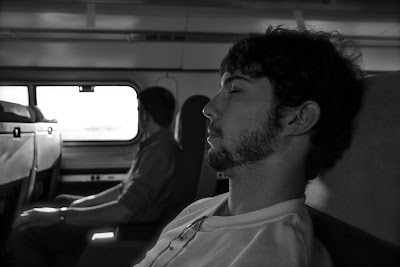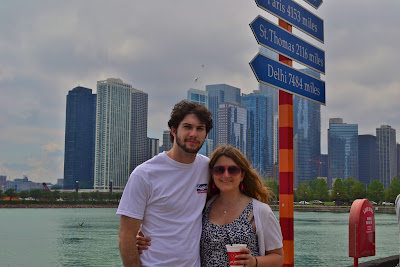I've happily come to terms with the fact that I've got this bug. My wallet may be lighter but, without it, I doubt Dave and I would have been able to say goodbye to our normal day-to-days for a full 2 week trip to glorious Italy this past fall. After I'm finished reviewing the vacation in full, you'll see that this trip, in particular, will always have a tremendously special place in my heart. As you may recall, Rome was up first. After immersing ourselves in its vast history for a week, I really didn't think the trip could get much better. Clearly, I was naive.
On Day 7, we packed up our bags and headed over to Roma Termini Station to begin our journey to the highly renowned Amalfi Coast. No one ever truly looooooves the actual act of traveling (except for maybe Daisy), so I wasn't giddy at the thought of the train - I was just eager to get there. However, I was surprised by the ease of the train system between Roma Termini and Napoli Centrale. There are simply a lot of options (always a good thing when on the road). If you prefer the get-me-there-faster train option, you'll pay a bit more for it. Having read that the slower, less expensive trains were overcrowded and had no assigned seats, we decided to go for the medium-speed train, either the IC or ICplus. The journey took us about 1 hr and 45 minutes and cost us about $75 (after the conversion to USD) for the one-way fare for the 2 of us.
Once off the train, you have a few options to get to the towns within the Amalfi Coast. I won't speak to renting a car yourself, because I would not recommend it.
 |
| Courtesy of Rick Steves, whose books I read vigilantly before and throughout the trip |
One option would be to take a taxi (although not generally recommended as they tend to gauge us poor, unsuspecting tourists). Nonetheless, if you feel compelled to take a taxi, make sure it's a fix price. For instance, when we eventually left the coast and headed back to Naples, we opted for a flat 90 Euro taxi that the hotel set up for us.
If you're not intimidated by public transportation, a decent option is to take the Circumvesuviana commuter train. The stop is in the basement of Centrale station. Sorrento is the last stop on the line (note that you'll pass by Pompeii along the way). Once you leave the Sorrento station, you'll see a series of SITA bus stops directly outside. You can't miss these buses approaching, as they catch your eye with their bright blue color (although sometimes they are white/green). Make sure to check the schedule ahead of time, and do pay attention to the F, H, G, S designations (which will tell you which run daily).
A few words of caution for you regarding the SITA buses:
- You need your tickets before you board! You can generally buy them at a nearby tabacchi shop. Sorrento to Positano will cost you about 4 euro, while Amalfi will run about 8 euro.
- They tend to be really crowded in the high-season. As long as you're early in Sorrento, I suspect you'd find a spot. The trickier part is coming back to Sorrento from Amalfi and Positano. For instance, if you get picked up at the 2nd stop in Positano, a lot of passengers have already loaded in from Amalfi and the 1st Positano stop. Thus, you may find that the bus is completely full. Make sure to have a Plan B!
- If you're not known for your speed & strength, just be prepared that you will be expected to load your suitcases in the undercarriage of the bus and jump on the bus quickly.
- The buses often times run ahead of schedule and do not wait. Make sure to get there early!
Another option would be to take a ferry from Naples to (i) Sorrento or to (ii) the island of Capri. If you opt for the Sorrento ferry route, then you could continue your journey by hopping on the SITA bus as I described above. If you go for the ferry to Capri, there are ferries from Capri's main port to Positano and Amalfi multiple times a day (even in the low season which starts at the end of Sept).
Our transportation choice from Naples was a private driver, an upgrade option offered by our hotel. After navigating substantial pedestrian and auto traffic within Naples and then traveling about an hour south, we got closer to Sorrento, the official "start" of the Amalfi Coast. At first, I thought the quickening of my heartbeat was a result of pure excitement over the views, but then I quickly realized that I was also in slight panic mode. Why you might ask? The roads were insane. Picture a narrow one-way road in the U.S. Then picture that same road being opened to two-way traffic, primarily dominated by large buses. Then add in extreme curves overlooking sheer vertical cliffs into the Mediterranean. Thankfully, these locals are pros and they maneuver their vehicles almost with ease, certainly without breaking into a cold sweat like me :P
Our transportation choice from Naples was a private driver, an upgrade option offered by our hotel. After navigating substantial pedestrian and auto traffic within Naples and then traveling about an hour south, we got closer to Sorrento, the official "start" of the Amalfi Coast. At first, I thought the quickening of my heartbeat was a result of pure excitement over the views, but then I quickly realized that I was also in slight panic mode. Why you might ask? The roads were insane. Picture a narrow one-way road in the U.S. Then picture that same road being opened to two-way traffic, primarily dominated by large buses. Then add in extreme curves overlooking sheer vertical cliffs into the Mediterranean. Thankfully, these locals are pros and they maneuver their vehicles almost with ease, certainly without breaking into a cold sweat like me :P
After passing through the equally if not more beautiful panoramic views of Positano and Amalfi, it was all "up" from there on out. Beautiful Ravello was our first destination, serenely perched up above Amalfi at a cool ~1,200 ft above sea level (abbreviated as "Rav." in Rick Steve's earlier map).
When we pulled up to Hotel Caruso at what seemed like the highest point in Ravello, my excitement level was off the charts. This was a splurge hotel for us (justified by the fact that I was able to use miles for our airfare). To describe our time here as anything more than a dream would be an understatement, but I will attempt to give you all the specific details in my next Amalfi Coast post ...

























































